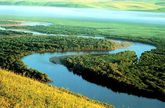ISSS608 2017-18 T3 Assignment SHI CHEN Visualization
|
|
|
|
|
Exploration Process
What is the overall chemical level in past 18 years?
Time division: In this case, time periods are divided into two, one is 1998-2013 so called “earlier years”, another is 2014-2017, which is “recent year”.
Based on the total chemical value in these streams throughout the past available years, as the year changes, the material content of the river shows an upward trend, with 2003 being the most serious year.
Looking closely, in earlier period of years, location Kohsoom, Busarakhan, Somchair had the higher chemical value, and Boonsri, Chai, and Sakda are lower. In recent years, chemical monitoring levels have declined in almost all locations, with the exception of the location Tansanee, the chemical content of this location has been at a high level.
Presumably1: Based on this situation, we can temporarily speculate that location Kohsoom, Busarakhan, Somchair may be subject to serious pollution in 2013, especially for the Kohsoom location.
Presumably2: Since Achara, Decha and Tansanee were added as observation station since 2009, it can be roughly speculated that these three location could be seen as dumping area too, since the chemical value in 2009 were much higher than other location in the same year. And the hydrological department added these three observation points in order to obtain a more accurate source of pollution.

